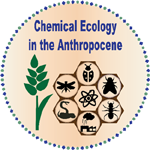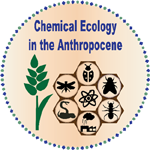How very simple molecules can occupy a chemical ecologist’s life
Anne-Geneviève Bagnères
CEFE, CNRS, Montpellier, France
The cuticular hydrocarbons present on the cuticle of all arthropods are very simple chemical substances. Nevertheless, they are always found in very complex mixtures and can reflect many biological, ecological and historical histories. Initially, they were thought to serve as chemotaxonomic traits, but it was soon shown that they were responsible for different types of individual recognition, sometimes through minute changes in their proportions. These modifications may reflect physiological changes, different ecological niches, hybridism or parasitism, but may also be the result of perfect mimicry. They may also be the cause of one of the most impressive insect invasions on several continents. However, after more than 35 years working on those molecules, we still do not understand how cuticular changes can be so rapid, or what happens biochemically and genomically, even though more or less recent experiments have helped us to understand this. So simple molecules does not mean simple science!
What I learned from Jim Tumlinson when I was his PhD student… and beyond
Ted Turlings
University of Neuchâtel, Switzerland
This lecture will honor the exceptional contributions of James (Jim) Homer Tumlinson III to the field of Chemical Ecology in general, but also to the scientific development of those who had the good fortune of working with him. Jim worked his way up from a modest upbringing on his family’s cattle and cotton farm in rural Mississippi to become one of the most innovative, respected, and productive chemical ecologists to date. His professional life started with a short but impressive military career, after which he decided that he was more suited to become a scientist. I will highlight several of his main achievements in chemical ecology, starting with his astonishing PhD research that led to the eradication of the cotton boll weevil. I will show how he often was one step ahead of his peers and that his work has been of great importance to crop protection. Many of the pheromones that he and his team identified are still being used worldwide for monitoring. I will finish with his group’s switch to highly impactful work on plant-insect interactions. With several memorable anecdotes, I will illustrate how Jim positively affected my approach to research, as well as that of others, including the next generation.
Floral fragrance for pollinators and beyond
Florian P Schiestl
Department of Systematic and Evolutionary Botany
University of Zürich, Switzerland
To attract pollinators, flowers use a variety of signals. Visual signals have long been assumed to be of primary importance for pollinator attraction, and only in the last decades we have discovered the beautiful diversity of chemical signals involved in plant-pollinator interactions. In my talk I will elaborate on some of the insights we have gained recently into the chemical ecology of floral fragrance. Whereas flowers often present a reward for their pollinators, deceptive flowers don’t, but attract pollinators with out-of-context signals, for example chemical compounds that insects use for mating or search for oviposition substrate. Such mimetic flowers are often pollinated in a highly specific way and chemical variation is typically involved in attraction of different specific pollinators. In the European orchid genus Ophrys, an example for sexual floral mimicry, alkenes and long chain esters are often important for mediating such specificity of pollinator attraction. In rewarding flowers, certain compounds can act as honest signal, i.e. those that are correlated to the sugar content of the flower reward. Such honest signals are learned by generalist pollinators and used by them to decide which flowers to visit. Phenylacetaldehyde, a very common floral scent compound, is an example of an honest signal in flowers of Brassica rapa, and bumblebees rapidly learn to use this signal. We have shown that this and other floral scent compounds have medium to high heritability and evolve rapidly under pollinator-mediated selection. Floral scent also impacts interactions other than pollination, for example plant-herbivore and other trophic level interactions. In a plant-herbivore-crab spider system we have shown that bee-pollinators positively select for increased scent emission, but crab spiders, that also use floral scent for finding flowers were they hunt for insects, remove this selection on scent. Crab spiders, however, feed not only on pollinators but also on herbivores, thus, when herbivore pressure is high, crab spiders are beneficial and plants are selected to attract them to herbivore-invested flowers, which is achieved by herbivore-induced floral scent emission.
Reflections on the Pherobase
Ashraf M. El-Sayed1
1The New Zealand Institute for Plant and Food Research Limited, BioProtection, Lincoln, New Zealand
E-mail: ashraf.elsayed@gmail.com
Almost 150 years ago, the first published observation of the sexual attraction of male moths to their females was made. A century later, bombykol the sex pheromone of silkworm was the first pheromone identified and the word “pheromone” was coined for the chemicals conveying information in interspecific interactions between individuals of the same species. Since then, pheromones have been identified from species across the entire animal kingdom, that extend from bacteria to elephants. The research on chemical communication has been expanded to cover chemicals that are involved in interspecific interactions between organisms. This has resulted in the identification of tens of thousands of compounds that convey information in intra- and interspecific interactions between organisms which were termed “infochemicals” or “semiochemicals”, with the latter being most commonly used by researchers.
With the accumulation of semiochemical discoveries in the past 60 years, there was a need to convert these discoveries into electronically searchable database entries. The Pherobase addresses this need and has been publicly available to the scientific community on the world wide web for around two decades. Currently, the Pherobase lists semiochemicals of almost 7000 species and the behavioural functions of about 15000 compounds. In addition, mass spectral data, NMR, and synthesis literature for more than 1500 semiochemicals are available. A separate section provides a list of applications of semiochemicals in pest management that can be categorized by region. Furthermore, the Pherobase lists about 2500 floral volatile compounds and 1700 plant species. Recently, a Kovats calculator and search was introduced, which enables users to calculate the Kovats retention index for a given compound and search Kovats values of over 35,000 organic compounds.
The Pherobase has proven to be a useful tool in semiochemical identification, understanding the evolution of chemical signals, pest management, and monitoring and detection of harmful pests. Over the years, The Pherobase has not only been used by chemical ecology researchers but also been accessed by researchers working in other fields including food chemistry, the pharmaceutical industry, and flavour and fragrance science.
Keywords: Semiochemicals, pheromones, database
Developing semiochemical-mediated, behaviorally-based management programs for pests in tree fruit and stored products
William R. Morrison III
USDA, Agricultural Research Service, Center for Grain and Animal Health Research, 1515 College Ave., Manhattan, KS 66502
Semiochemical-mediated, behaviorally-based management tactics include those that use volatiles at a distance to manipulate the behavior of the pest population to protect the commodity of interest. This includes a suite of tactics, namely attract-and-kill, mating disruption, push-pull, among others. Over the last 10 years in my career, I have focused on developing attract-and-kill in apple orchards against Halyomorpha halys (Hemiptera: Pentatomidae), as well as against a variety of stored product insects. In deploying high doses of H. halys aggregation pheromone + a pheromone synergist along the perimeter of apple blocks, attract-and-kill successfully reduced damage by 2–7-fold, while at select baited trees, over 10,000 individuals were killed. The crop area treated with insecticide against H. halys was reduced by 97%. Against stored product insects, we used an interception trap design, and found an SPB lure (Insects Limited) was most attractive in the wind tunnel and release-recapture assays, though increasing the number of lures did not increase attraction by insects. We found that long-lasting insecticide netting was a successful kill mechanism, preventing progeny production. Over 2 years, interception traps deployed for 48-h periods on the perimeter of commercial food facilities in two US States captured over 3,000 insects, representing 14 stored product insect taxa. Overall, we demonstrate a successful proof-of-concept for attract-and-kill in tree fruit against H. halys, and show significant progress in developing a behaviorally-based strategy against stored product insects. Ultimately, adoption of behaviorally-based tactics may reduce insecticide usage where they are adopted for the pests driving pest management programs.

